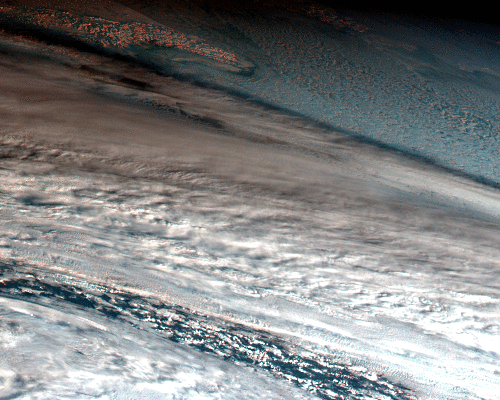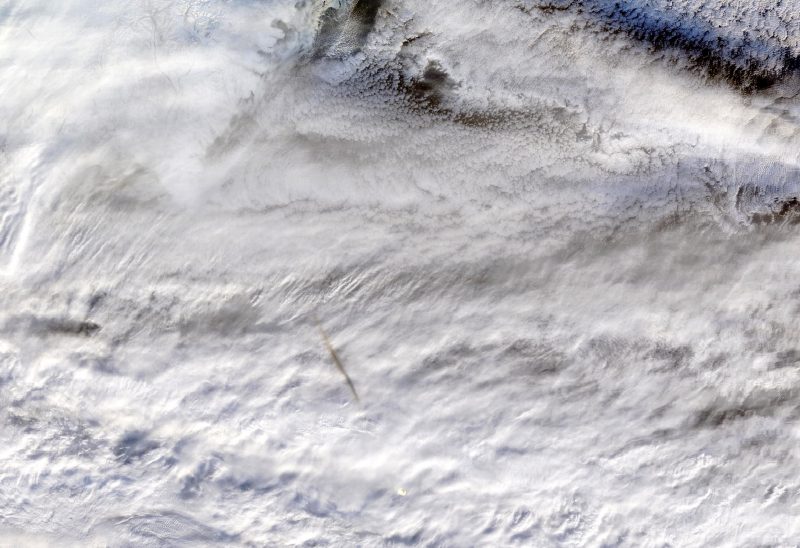Great images of fireball over Bering Sea
Deborah Byrd in EARTH | SPACE | March 24, 2019
Last December 18, a big “fireball” or bright meteor exploded above the Bering Sea with more than 10 times the energy of the atomic blast over Hiroshima. Satellites saw it all.
Animation via NASA GSFC.
A NASA instrument aboard the Terra satellite captured images of a fireball – or extremely bright meteor – over the Bering Sea on December 18, 2018. The images shows the fireball as well as the meteoroid’s path, marked by a dark trail of smoke over thick, white clouds. NASA said the meteor exploded about 16 miles (26 km) above the Bering Sea. The explosion unleashed an estimated 173 kilotons of energy, or more than 10 times the energy of the atomic bomb blast over Hiroshima during World War II.
In describing the animated image above, and the still image below, NASA said:
Two NASA instruments aboard the Terra satellite captured images of the remnants of the large meteor. The image sequence shows views from five of nine cameras on the Multi-angle Imaging SpectroRadiometer (MISR) instrument taken at 23:55 Coordinated Universal Time (UTC), a few minutes after the event. The shadow of the meteor’s trail through Earth’s atmosphere, cast on the cloud tops and elongated by the low sun angle, is to the northwest. The orange-tinted cloud that the fireball left behind by super-heating the air it passed through can be seen below and to the right of the GIF’s center.
The still image, captured by the Moderate Resolution Imaging SpectroRadiometer (MODIS) instrument, is a true-color image showing the remnants of the meteor’s passage, seen as a dark shadow cast on thick, white clouds. MODIS captured the image at 23:50 UTC.
True-color image of a fireball over the Bering Sea on December 18, 2018, via NASA.
NASA also said:
… the December 18 fireball was the most powerful meteor to be observed since 2013; however, given its altitude and the remote area over which it occurred, the object posed no threat to anyone on the ground.
Fireball events are actually fairly common and are recorded in the NASA Center for Near Earth Object Studies database.
Bottom line: On December 18, 2018, satellite instruments captured images of a big “fireball” – or bright meteor – exploding above the Bering Sea with more than 10 times the energy of the atomic blast over Hiroshima.
 |
 |
|
|||||||||||
 |
 |
||||||||||||
|
|
|
|
|
|
|
||||||||
 |
|
|
|
|
|
 |
|||||||
|
|
|
|
|||||||||||
|
|
|||||||||||||
|
|
|
|
|
|
|
|
|
|
|
|
|
|
|
Results 1 to 1 of 1
-
03-30-2019, 01:16 PM #1
Meteor exploded above the Bering Sea
Beginner's Guide for Rocket, NFPS and IKS66...
http://iptvtalk.net/showthread.php?2...-you-should-do
Kodi Options for Rocket, NFPS and IKS66...
http://iptvtalk.net/forumdisplay.php?71-Kodi
Check the Announcement Section...
http://iptvtalk.net/forumdisplay.php...-Announcements
Similar Threads
-
Lyrid meteor shower
By ilan in forum The Universe Closer to HomeReplies: 0Last Post: 04-21-2020, 12:37 PM -
Meteor Outburst
By ilan in forum Maps to the StarsReplies: 0Last Post: 11-17-2019, 01:13 PM -
Asteroid 2019 MO exploded in our atmosphere
By ilan in forum The Universe in ReviewReplies: 0Last Post: 06-27-2019, 12:03 PM -
Man In Ohio Claims Apple’s iPhone XS Max Exploded In His Pocket
By Ryu in forum Apple OSReplies: 2Last Post: 12-30-2018, 02:55 AM -
An asteroid exploded over Russia
By ilan in forum The Universe Closer to HomeReplies: 2Last Post: 06-23-2018, 04:27 PM








 Reply With Quote
Reply With Quote